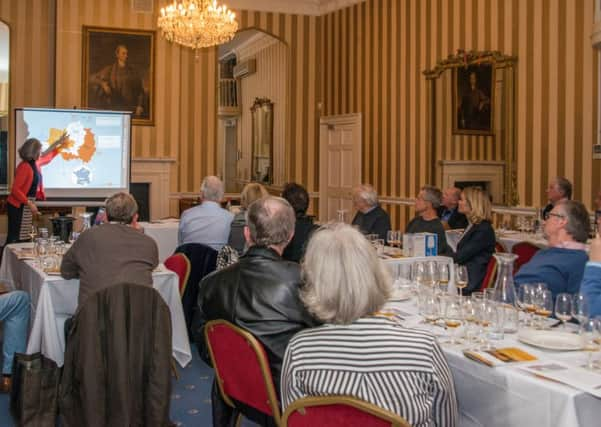RICHARD ESLING: Armagnac '“ one of France's well-kept secrets


Words to make Amanda Garnham’s blood boil. The only true part of any of this is that Armagnac comes from the south west of France.
But in terms of quality and flavour, it is a match for cognac and indeed better than a great many. It’s just different and rustic it is definitely not.
Advertisement
Hide AdAdvertisement
Hide AdAmanda is the press attaché and head of marketing for the Bureau National Interprofessionel d’Armagnac. Based in the Gers in South west France, she came to Arundel last week to present an Armagnac Masterclass to a joint meeting of the Arundel Wine Society and Sussex Wine Academy. After an interesting and detailed explanation of how this lesser known French brandy is produced, followed by a comprehensive tasting of Armagnac from seven different producers, everyone present was left in no doubt that Gascony produces some of the finest, elegant and most characterful brandy in the world.
Armagnac is, in fact, the oldest brandy produced in France dating from at least as far back as the 14th century. It predates the production of the better-known brandy – cognac – by some 150 years. Both are made from distilled wine, although the regions and grape varieties differ. Armagnac is perhaps, one of France’s well-kept secrets and to some extent, it needs to be or else there wouldn’t be enough to go around. The annual production of cognac is about 150 million bottles, whereas Armagnac production is a mere six million.
Although there are some small family firms producing cognac, the vast majority comes from the big industrial companies and a few brands dominate the industry.
Armagnac, on the other hand, is all produced by small, family owned businesses, who are passionate about their region and the brandy that they make. There are three appellations – Bas Armagnac, Haut Armagnac and Ténarèze. Neither is better than the other, they are just different. They are all in the Pays de Gascogne, country of the Musketeers and the famed D’Artagnon.
Advertisement
Hide AdAdvertisement
Hide AdGascony is a beautiful, rural and sparsely populated region of France and vineyards nestle on the hills or by the forests, with such grape varieties as Ugni Blanc, Folle Blanche, Baco and Colombard being grown there. Thin, acidic wines made from these varieties are then distilled in either pot stills or small, mobile continuous stills to produce a spirit which is about 55 percent alcohol and contains a lot of flavour components, which give Armagnac its particular character. The newly distilled spirit is then run into oak casks where it matures for varying periods of time, depending on the style to be produced. Many different styles are produced combining the differences of soils where the vines are grown, grape varieties, oak and length of ageing.
Old Armagnac is complex and multi-dimensional, the sort of drink to sit down and contemplate. There are those which contain blends of spirit distilled in different years and those which come from a single vintage. The designation of XO is about to change from April this year, increasing the minimum age of the contents of the bottle from six years to ten. In fact, many producers that label their bottles as XO, age their brandy for longer than this already, with some being 20 years old or more.
The range of seven Armagnacs had been selected from among the top producers and demonstrated the glorious range of flavours and characteristics which exist.
From the Baron de Sigognac VSOP (£31.25 from the Whisky Exchange) to the Chateau de Lacquy 2000 (Master of Malt £97.40) and Delord 25-year-old (Oxford Wine £59.50), each had its group of protagonists, with flavours and aromas reminiscent of prunes, dried apricots, roasted almonds, caramel and candied fruits.
Advertisement
Hide AdAdvertisement
Hide AdThe Castarède XO 20-year-old and Chateau de Pellehaut Reserve in its decanter shaped bottle, were firm favourites with many tasters, although the Domaine d’Esperance and Domaine de Laubade met with equal approval.
So, if you are looking for a brandy with, body, flavour, elegance and complexity combined, choose Armagnac.
Richard Esling BSc DipWSET is an experienced wine consultant, agent, writer and educator. An erstwhile wine importer, he runs a wine agency and consultancy company called WineWyse, is founder and principal of the Sussex Wine Academy, chairman of Arundel Wine Society and is an International Wine Judge. Twitter @richardwje. Visit www.winewyse.com.
Don’t miss out on all the latest breaking news where you live.
Advertisement
Hide AdAdvertisement
Hide AdHere are four ways you can be sure you’ll be among the first to know what’s going on.
1 Make our website your homepage
2 Like our Facebook page
3 Follow us on Twitter
4 Register with us by clicking on ‘sign in’ (top right corner). You can then receive our daily newsletter AND add your point of view to stories that you read here.
And do share with your family and friends – so they don’t miss out!
Be part of it.